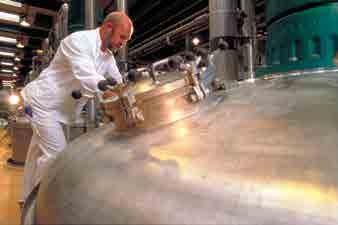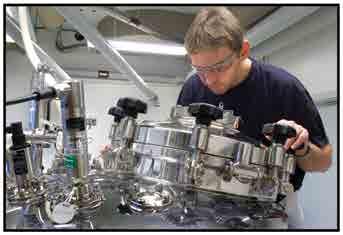
10 minute read
Uneven growth Global pharma industry held up by Europe’s slow recovery
UNEVEN GROWTH
Mixer on the No.3 granulation line Novo Nordisk’s fermentation factory in Kalundborg, Denmark Uphill deduster and product diverter on the No.10 tableting line



The global pharmaceutical market continues to grow, but the slow economic recovery in Europe is still having an effect. Sarah Houlton casts her eye over the biggest stories from the pharma industry over the past year, in which acquisitions, new in-licensing deals and a focus on fighting Ebola have all featured prominently.
Global annual spend on medicines is set to top $1 trillion for the first time in 2014, having ended 2013 just shy of that figure at $989 billion. The market continues to grow – the IMS Institute for Healthcare Economics predicts that by 2018 it may top $1.3 trillion in its recent report, ‘Global outlook for medicines through 2018’. But, they caution, while the global economic recovery is set to strengthen in the next couple of years, the pharma growth rate will peak at 7 per cent in 2014. And there remain significant risks from an uneven economic recovery in Europe, political tension within Russia, and the fallout of recent events in Africa and the Middle East.
Combining strengths
The trend for companies to drive growth via merger and acquisition continues. While there were no true mega-mergers after AstraZeneca rebuffed Pfizer’s advances in May, the usual host of smaller deals kept market-watchers busy. One of the more interesting was USbased Botox-maker Allergan, which was being stalked by notoriously slash-and-burn Valeant, but instead sold out to Dublin-based Actavis, whose stance on R&D is rather less negative than Valeant’s. Roche company Genentech was also on the acquisition trail, buying breast cancer specialist Seragon.
There were also a couple of notable spinouts. Bayer announced it is hiving off its materials science business to focus on its life sciences operations, in pharma and agrochemicals. Reckitt Benckiser is spinning out its pharma business into a separate entity, Indivior. This will allow it to focus on its consumer health business. Merck & Co, meanwhile, is going the other way, selling its consumer care products to Bayer.
There was also the usual spate of inlicensing deals as big pharma looked to refill its pipelines. AstraZeneca announced a whole host of them, including with Almirall and with Synairgen, with a particular focus on respiratory and cancer projects. It also bought out Bristol-Myers Squibb’s diabetes business, an area in which the two companies had previously been cooperating.
Novartis got a little more creative, announcing two big asset swap arrangements and a joint-venture in April. It has acquired GlaxoSmithKline’s oncology portfolio for $14.5 billion, and in return GSK paid $7bn for Novartis’ vaccine division, with the exception of its flu vaccines. It also sold its animal health business to Lilly, increasing its focus on human health. In addition, Novartis and GSK have combined their consumer health portfolios via a roughly 1:2 joint venture.
Blister-packing line at the packaging facility in Kaiseraugst: a vibratory conveyer feeds product into the line Pharmaceutical production

Making cuts
Some companies this year have been obliged to make some difficult decisions. For example, Danish company Novo Nordisk announced cuts in September: the company is getting out of inflammation R&D in the wake of the failure of its anti-IL-20 rheumatoid arthritis candidate in clinical trials. This will lead to the loss of 400 jobs, although it hopes to deploy up to half elsewhere in the business. However, it also said in June it had plans to add 6000 new jobs in Denmark – half in R&D and the rest in production – by 2022.
Novartis announced it is shuttering its US manufacturing site in Suffern, NY, where blood pressure drug valsartan (Diovan) is manufactured. It’s part of a worldwide restructuring operation the company says will ultimately involve up to 4000 job cuts, while many back-office operations (including some from its corporate HQ in Basel, Switzerland) are consolidated at several facilities around the world, including a new one in Hyderabad, India. In contrast, its rival Roche announced a SFR3 billion investment at home in Basel, creating new and upgraded lab space. More than half of this investment will be in a new research centre, set to be ready by 2022.
More positive news came with the announcement that Boehringer Ingelheim’s site in Petersburg, VA is not to close after all; rather, it is being acquired by Chinese manufacturer UniTao Pharmaceuticals in a bid to increase its market share in the US. However, another Irish manufacturing site is to go – BMS’s facility in Cruiserath.
With the growing expense of Phase III clinical trials in areas such as diabetes, it is perhaps unsurprising that various of the big pharma companies are sharing the financial risk and joint-funding clinical development programmes. AstraZeneca and Lilly, for example, are collaborating on Phase II/III trials of the BACE inhibitor AZD3293, and Pfizer is working with Merck KGaA on studies of an anti-PD-L1 antibody as a cancer immunotherapy. More such risk-sharing agreements are surely inevitable in future.
Focus on fighting Ebola
The Ebola outbreak in west Africa highlights just how long trials normally take, and how the timeline can be shortened significantly if the serious unmet medical need greatly outweighs the risks of pressing ahead with shorter trials and a telescoped development process in the interests of speed. Early data from Phase I trials on an ebola vaccine developed at Okairos, now acquired by GSK, and the US National Institute of Allergy and Infectious Diseases showed it appears safe and gives an immune response, generating anti-Ebola antibodies. It is still some way from being a product that can be used in the field, but the speed with which it has been pushed through these early safety studies have certainly accelerated its potential widespread use, if all goes well in the next stages of development.
Other vaccines are in development, including at Merck & Co, which acquired rights to NewLink’s experimental vaccine, and J&J is set to start trials on another vaccine in early 2015. Numerous investigational drugs, such as the antibody combination ZMapp and Tekmira’s TKM-Ebola have also been used as an emergency measure. Several experimental drugs have been around for some time, but lack of funding led to many being shelved. The current outbreak has shifted the priorities somewhat.
High approval levels
It was a pretty good year in terms of approvals, with more than 30 novel drugs gaining marketing recommendations by the European Medicines Agency. IHII predicts that we are now hitting a second ‘wave’ of innovation, similar to the annual new drug approvals rate of the early 2000s.
Almost half of late-stage pipeline products are designed to treat cancer, infection and disorders of the central nervous system – indeed, they predict that $100 billion of global drug spend will be on cancer treatments by 2018. Sure enough, as has become commonplace in recent years, various new anticancer agents were approved. These include GSK’s trametinib (Mekinist) for melanoma, the first drug to act via inhibiting the protein kinase MEK, AZ’s olaparib (Lynparza) for ovarian cancer, a first-in-class PARP inhibitor, and Roche’s B-cell targeting





Employee in the filling station of the Supply Centre at Bergkamen, Germany. Image author: Bayer HealthCare AG

antibody obinutuzumab (Gazyvaro), which treats chronic lymphocytic leukaemia.
Roughly a third the 2014 approvals were drugs given an orphan designation, designed to treat rare diseases. These included Janssen’s siltuximab (Sylvant), the first agent approved for Castleman’s disease, which causes enlarged lymph nodes and increases the risk of infection, kidney failure and cancer.
For years, hepatitis C treatment relied on the unpleasant combination of interferon plus the antiviral ritonavir being dosed for a year, with no guarantee of success. It’s become a real hot therapeutic area in the past couple of years, following the approval of boceprevir (Victrelis, Merck), telepravir (Incivek/Incivo, Vertex) and sofusbuvir (Sovaldi, Gilead), and several further new agents to treat hepatitis C were also green-lighted in 2014. These include simeprevir (Olysio) from Janssen, daclatasvir (Saklinza) from BMS, and two products from Abbvie – dasabuvir (Exviera), and a triple combination, Viekirax, which includes two new agents, ombitasvir and paritaprevir, with the old drug ritonavir.
While prognosis still depends on virus genotype and the new drugs are costly, they do open the door to a potential cure for more patients with hepatitis C infection. The Gilead drug also highlighted the pricing problem – at $84,000 per patient for a 12-week course of treatment, it is massively expensive, and is expected to top $10 billion in sales in 2014. If a patient is cured, the savings in downthe-line treatment costs will be significantly higher, but that headline-grabbing number causes alarm, and negative headlines about greedy pharma companies.

Negative publicity
Some of the worst headlines of 2014 came courtesy of GSK’s corruption charges in China – it was fined $300m for corruption, and there is also talk of bribes having been made in Iraq. But other companies have been facing legal battles, too. Both GSK and Pfizer settled US lawsuits over the off-label promotion of drugs. And Servier was named and shamed in medical press adverts for breaching the Association of the British Pharmaceutical Industry’s code of practice on clinical trials transparency.
Patents are frequently the subject of lawsuits, and Amgen is going the whole hog over PCSK9 antibodies designed to lower cholesterol – it is suing Sanofi and Regeneron claiming that its intellectual property covers not just the antibody it is pushing through clinical development, evolocumab, but any PCSK9 antibody. Others under development include Regeneron and Sanofi’s alirocumab, and Pfizer’s bococizumab. Such broad patent claims have been disallowed in small molecules, and it will be interesting to see if the courts take a different view in the antibody field.
On the manufacturing side, an alarming report from India on the deaths of 13 women – and the illness of more than 100 more – in a sterilisation programme in Chhattisgarh appears to be not a result of botched surgery but contaminated medicines. They were given the antibiotic ciprofloxacin, but the tablets made by Mahawar Pharmaceuticals were contaminated with toxic substances including zinc phosphide, commonly used as a rat poison, which releases phosphine gas on contact with stomach acid. The tablets also contained only 60 per cent of the correct dose. When raided, officials found evidence of burnt drugs at the company’s premises.

A costly business
The cost of developing a new drug is commonly cited as $1bn, thanks to research published more than a decade ago by the Tufts Center for the Study of Drug Development in Boston. They have now upgraded their calculations, and put the cost of getting a new drug onto the market at a little over $2.5 billion.
“Drug development remains a costly undertaking, despite ongoing efforts across the full spectrum of pharmaceutical and biotech companies to rein in growing R&D costs,” says Joseph DiMasi, the study’s principle investigator. “Because the R&D process is marked by substantial technical risks, with expenditures incurred for many development projects that fail to result in a marketed product, our estimate links the costs of unsuccessful projects to those that are successful in obtaining marketing approval from regulatory authorities.”
The costs have increased by 145 per cent between the 2003 study and the most recent study – a compound annual growth rate of 8.5 per cent. DiMasi says that larger and more complex clinical trials are one of the main drivers of this increase, as well as testing on comparator drugs to meet payer demands for comparative effectiveness data. n










